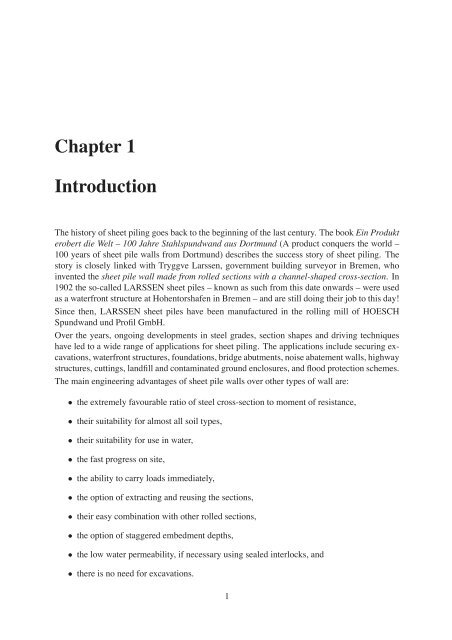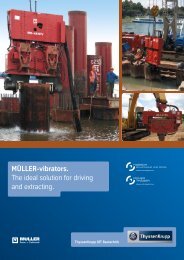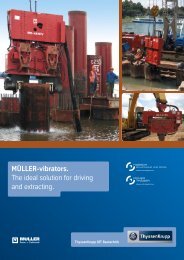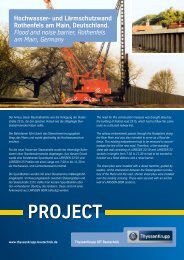pdf (3.6 MB) - ThyssenKrupp Bautechnik
pdf (3.6 MB) - ThyssenKrupp Bautechnik
pdf (3.6 MB) - ThyssenKrupp Bautechnik
Create successful ePaper yourself
Turn your PDF publications into a flip-book with our unique Google optimized e-Paper software.
Chapter 1<br />
Introduction<br />
The history of sheet piling goes back to the beginning of the last century. The book Ein Produkt<br />
erobert die Welt – 100 Jahre Stahlspundwand aus Dortmund (A product conquers the world –<br />
100 years of sheet pile walls from Dortmund) describes the success story of sheet piling. The<br />
story is closely linked with Tryggve Larssen, government building surveyor in Bremen, who<br />
invented the sheet pile wall made from rolled sections with a channel-shaped cross-section. In<br />
1902 the so-called LARSSEN sheet piles – known as such from this date onwards – were used<br />
as a waterfront structure at Hohentorshafen in Bremen – and are still doing their job to this day!<br />
Since then, LARSSEN sheet piles have been manufactured in the rolling mill of HOESCH<br />
Spundwand und ProfilGmbH.<br />
Over the years, ongoing developments in steel grades, section shapes and driving techniques<br />
have led to a wide range of applications for sheet piling. The applications include securing excavations,<br />
waterfront structures, foundations, bridge abutments, noise abatement walls, highway<br />
structures, cuttings, landfill and contaminated ground enclosures, and flood protection schemes.<br />
The main engineering advantages of sheet pile walls over other types of wall are:<br />
• the extremely favourable ratio of steel cross-section to moment of resistance,<br />
• their suitability for almost all soil types,<br />
• their suitability for use in water,<br />
• the fast progress on site,<br />
• the ability to carry loads immediately,<br />
• the option of extracting and reusing the sections,<br />
• their easy combination with other rolled sections,<br />
• the option of staggered embedment depths,<br />
• the low water permeability, if necessary using sealed interlocks, and<br />
• there is no need for excavations.<br />
1
















